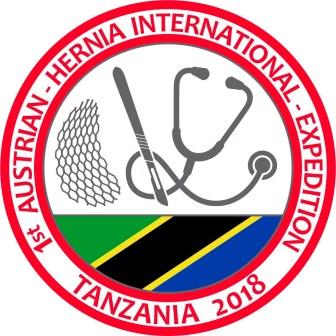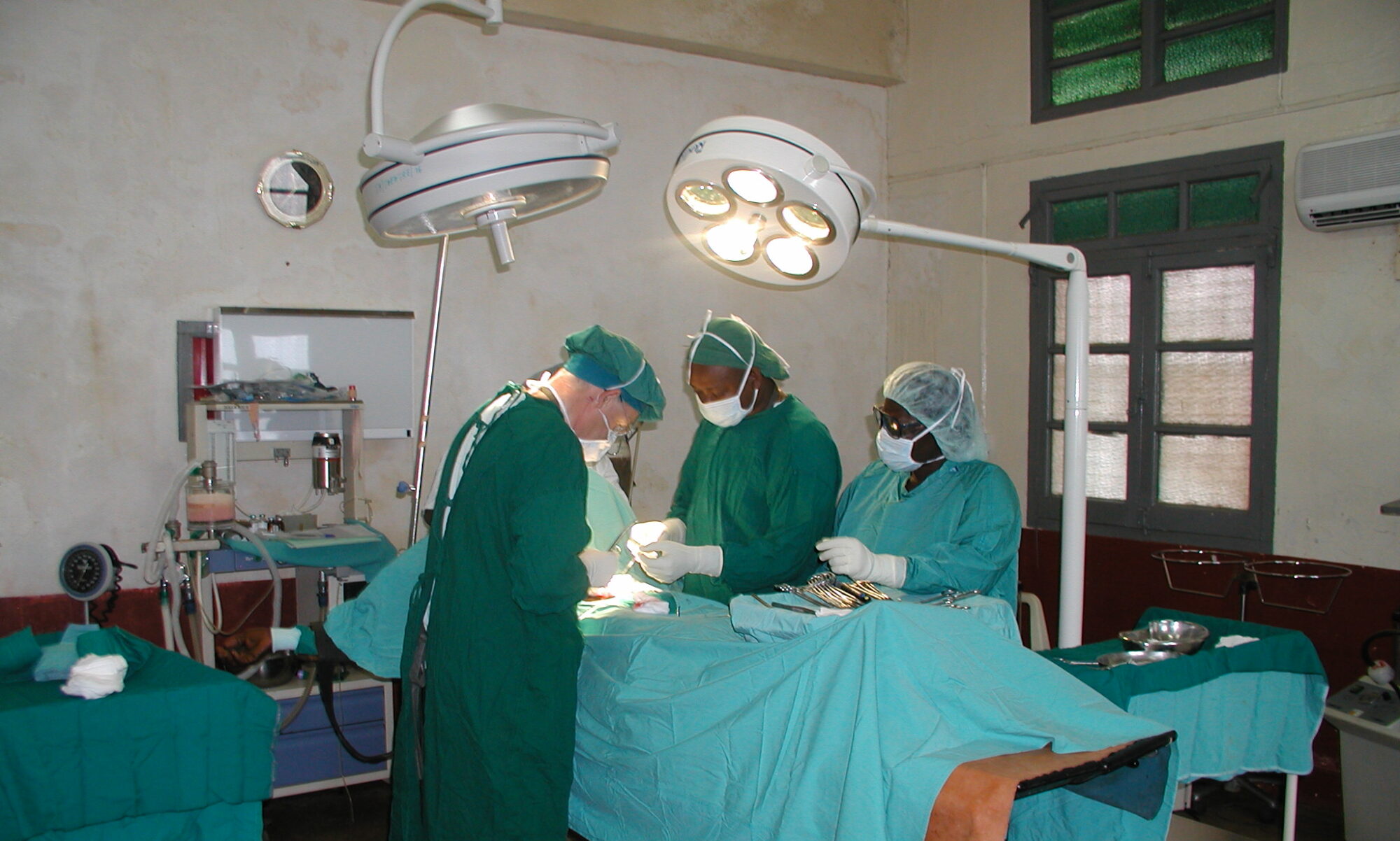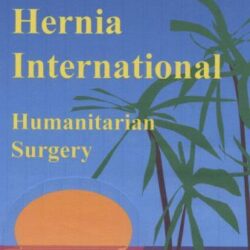TANZANIA 2 0 1 8
1st Austrian “Hernia International Foundation” Mission
Korogwe, February 24th – March 3rd 2018

Our group was the 10th Hernia International team to Korogwe. It consisted of 6 members: 2 surgeons, 2 anaesthesiologists, 1 radiologist and 1 nurse anaesthetist.
Before our travel, we did not all know each other. Through common friends, a team was assembled , which later showed to be a good one. We travelled separately. Unfortunately, the intended plan to host the first African surgeon on Hernia International Mission (Dr. Peter George from Liberia), had to be abandoned due to problems during his flight. The team met in Triniti Hotel close to Dar es Salaam airport. After breakfast, we travelled to Korogwe on mainly good, but busy roads for the next 6 hours. During this trip, and later on in the hospital, an observation was made that after being here in 2015, Tanzania has been making progress in every sense (roads, traffic rules, infrastructure,…). In Korogwe hospital, we were warmly welcomed by the hospital’s medical director and Dr. Avelina Temba as the 10th Hernia International team, after starting in 2013.

Warm welcome in front of the Korogwe hospital
Immediately after that, we visited the patients and arranged the surgical programme for the first day. We nearly managed to retain all of our equipment with just 1 piece of lost luggage missing. We bought sutures from a local pharmacy. Operations were planned parallel on 3 tables, however this had to be reduced due to the unpredicted absence of 1 surgeon. However, our host, Dr. Temba was willing to operate on table 3 on almost all days. Operations started with 3-4 paediatric cases on table 1, these patients got general anaesthesia and caudal blockage, then we continued with adults, mostly also in general anaesthesia due to large hernias. On table 2, mainly large inguinoscrotals, up to H420 cm-(Kingsnorth classification) were performed mainly in spinal anaesthesia. On table 3, Dr. Temba performed diverse procedures, mostly in local anaesthesia, partly in spinal as well. Table 1 and 3 were sometimes occupied by local surgeons performing emergency procedures. A very well organised, local team was of big help to us. Also, there was a big interest from local surgeons to learn modern hernia procedures.
1 OT was well air-conditioned, the other partly (AC was out of order on the second day) so Maria and Marija showed a lot of bravery, working at 37 oC while wearing surgical coats. Strong headlights were a good idea to take with us. Although lighting were working in 2 theatres properly, they were not very bright. The diathermies were working well, despite regular power cuts.

Maria and Dr Agripina during surgery

Jurij during teaching retrorectal Rives-Stoppa
In the first three days, the work in all three operating theatres (OTs) ran smoothly from 8 am to 9 pm or even later. Arranging the surgical programme for the following day was the last task every evening. On day 3, after a good dinner in a local grill restaurant on Korogwe main road, we decided to reduce the working hours for next 2 days. This was done partly allowing teambuilding and to enable the local staff to relax and tidy up in the evenings. On the next day, after finishing surgery, we were honoured by visiting the monastery and private hospital of The Sisters of Usumbaya (a catholic order of sisters, to whom surgeons Dr. Avelina, Dr. Archangela and Dr. Dativa belong). Around their monastery various tropic trees with diverse fruits were growing, and considering the peaceful atmosphere of people praying, we almost had the impression of being in the garden of Eden. The private St. Joseph Hospital close to the monastery has just been expanded with a new maternity ward. In this building, a donated ultrasound machine, a gift from Dr. Michael Wutte from Austria, which we brought to Tansania, will be installed.
On the last day, after finishing surgery, we visited a local market acompanied by surgeon Dr. Ahmad and were in awe of the diversity of groceries and other articles sold by the locals. The final evening party, organised by ourselves and hospital staff in our guest house (Magnificent Korogwe Resort), consisted of speeches thanking the work that had been done, a buffet dinner and some dancing.
Special thanks were given to local surgeons, who performed the early morning rounds every day for all of the patients. This was a big time saving for us, allowing us to start with surgery immediately after arriving to the hospital. The Korogwe hospital has about 15 doctors and 100 beds, making this organisationally possible. We personally checked dressings and removed drainages in incisionals and some large inguinoscrotal hernias Korogwe hospital has about 100 beds, around 15 doctors are working there.



Michael, Hannes and Sarah during education, which was an important part of our mission
Ultrasound procedures were very useful not just for our patients (undescended testicles, hernias, …), but also for emergencies. Unfortunately, regular power cuts limited the number of ultrasound checks we could carry out. When Marija, our radiologist, was not busy in X-ray department, she assisted Maria in OT2. Women are capable of multitasking! This proof came also from Sarah, the anaesthesia nurse, who helped everybody, besides being a great support to our skilled anaesthesiologists Michael and Hannes.
Lunch break and refreshments were always welcome. The kitchen lady Scholastica took abundant care of us (rice, vegetables, some local specialities, chicken, water, coffee, peanuts).
Staying in Magnificen Korogwe Hotel was a good suggestion, given to us by Dr. Katharina Wentkowski from Switzerland. It is much closer to the hospital than other Korogwe guest houses. 20 USD/night was reasonable, but there was no WIFI available This was solved by our radiologist, who bought a local Tanzanian SIM card and offered us to use the hotspot.
In 5 working days we performed 72 procedures on 66 patients (16 female, 50 male) on 2, sometimes 3 tables. Our anaesthesia team performed two additional long-term general anaesthesia’s for emergencies. The average age of the patients was 44,4 years. The oldest patient was 100 years old (no official confirmation), the youngest 1 year and 2 months. The majority of patients had large inguinoscrotal hernias (34).
We repaired inguinals using the Lichtenstein (33 patients) and the Shouldice technique with one young patient. In 15 paediatric patients with inguinal hernia, the Mitchell Banks and Ferguson techniques were used. We performed 4 incisional repairs (2 sublay – retromuscular Rives Stoppa and 2 onlays), 11 direct umbilical repairs, 2 undescended testicle repairs (orchidopexies). We were blessed having no complications. The anaesthesia was predominantly spinal with 43 cases, 22 patients had a general anaesthesia, local anaesthesia was done in just 11 cases.
A lot of above mentioned procedures were partly or fully performed by local staff (surgeons, anaesthesiologists, nurses).
For the second time, the presence of a radiologist on our mission confirmed to be a good idea: 12 performed ultrasound diagnostic checks preoperatively, 12 other outpatient ultrasounds, 2 emergency ultrasounds and 18 sonography checks on pregnant women (altogether 44, including education).
Special thanks go to the well coordinated work between anaesthesia and surgery and of course, with local experts. We did not need to talk much to find right solutions in situations that needed to be discussed. The comment of Dr. Avelina was very appropriate: » It was a calm and blessed mission«.

Although we travelled as the 1st Hernia International team from Austria, our skill, experience and enthusiasm originates from different countries and hospitals. The anaesthesia team comes from large clinic (Feldkirch in Vorarlberg) in the west of Austria and surgical team comes from Carinthia (south Austria). The radiologist, whose task was performing preoperative ultrasounds and introducing the donated ultrasound machine to local doctors, came from Ljubljana clinical centre (Slovenia).
– Michael Wirnsperger (consultant, anaesthesiologist, 1st mission)
– Hannes Lienhart (consultant, anaesthesiologist, 1st mission)
– Sarah Bertsch (anaesthesia nurse, 1st mission)
– Marija Jekovec (consultant, radiologist, 2nd mission)
– Maria Greiner (consultant, surgeon, 2nd mission)
– Jurij Gorjanc (consultant, surgeon, team coordinator, 8th mission)
To view a short film about the mission, click on the following link:
https://drive.google.com/file/d/1ybgCiGFt-re7jdts3lpVskLRhiBWy61e/view


